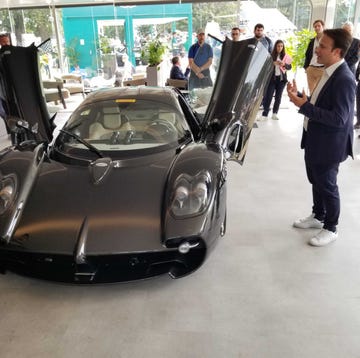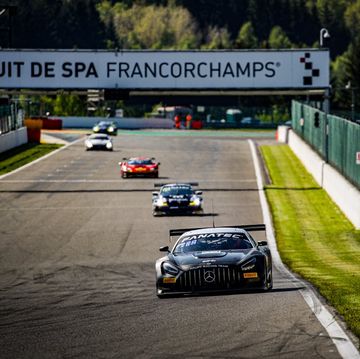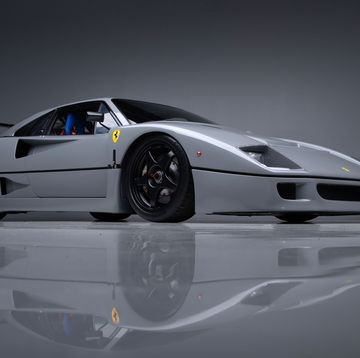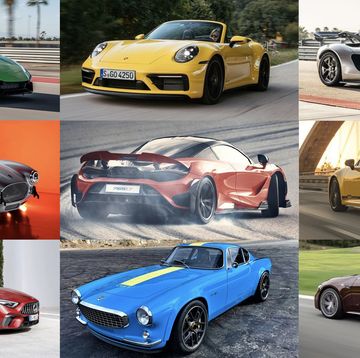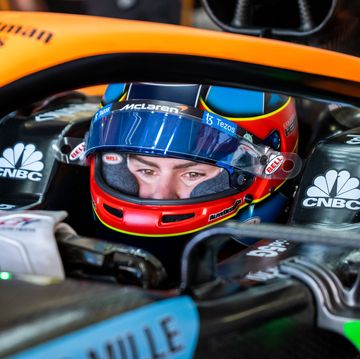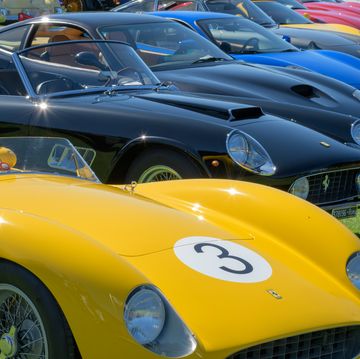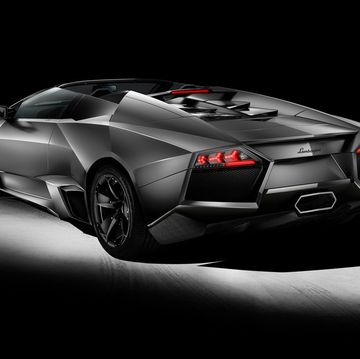- The McLaren Artura is the hybrid stepping stone to our electric future.
- At 3443 pounds it's ridiculously light for a hybrid, even with its 7.4-kWh battery. It's 257 pounds lighter than the Ferrari 296 GTB, which otherwise shares its basic specs.
- Pricing is an entirely reasonable $237,500, about 85 grand less than the Ferrari.
It seems that somewhere in the not-too-distant future all of our supercars will be electric. Consider the Pininfarina Battista, Rimac Nevera, and even the Tesla Model S Plaid. All those and those to come replace the roar of a V8 or V12 internal-combustion engine with the robotic whirrs and clicks of pure electric juice.
They are quicker and to an extent faster than the traditional roaring gasoline-fed howlers of horsepower that defined supercar power since the first Mercedes/Duesenberg/Takeyerpick car ever got the “super” prefix slapped on its front end.
But not everything’s going to be all-electric. At least not right away. So when McLaren realized the mortality of the gasoline-fed combustion engine, it didn’t want to shock us (get it?) by dropping gas altogether and going to batteries. Instead, it straddled both sciences and went with a hybrid.
Behold, the Artura, the best of both worlds.
The Artura drops down from McLaren’s traditional V8 by two cylinders and slaps a pancake-flat electric motor where the missing cylinders used to be. The resulting hybrid powerplant makes 671 certified horsepower, 531 lb-ft of torque and relatively few emissions.
But I know what you’re thinking…
Comparisons to the Ferrari 296 GTB are inevitable: Both have electrified hybridized 120-degree 3.0-liter V6s sitting amidships and driving the rear wheels. Both look extraordinarily cool, and both are about as thrilling to drive as almost anything you have ever driven, guaranteed. Indeed, for a while it looked like McLaren would beat Ferrari to market, but electronic gremlins (the ghost of Lucas Electrics?!) meant a delay in delivering the Artura (and possibly caused the ouster of McLaren’s affable CEO Mike Flewitt).
So how do the two compare? The Ferrari also has 3.0 liters of displacement mated to an electric motor but manages to make 818 hp to the Artura’s 671. The Ferrari weighs 3700 pounds to the McLaren’s 3443. So the Ferrari’s just barely slower—2.9 vs. 2.6 seconds to 60 mph. Yet, the 296 feels just a little more edgy, a little more brutale, a little more like a true track car.
I drove the Ferrari a year ago on both a racetrack and on country roads in Spain. The McLaren I drove last week on my favorite two-lane twisty highway above Los Angeles. In the rain. There was mud on some patches of road, and snow at the top where the road had washed out. So these were less than ideal conditions. And it rained a little in a winter where it rained a lot.
There are a couple oddities in the McLaren. There’s no reverse gear in the eight-speed transmission. You back up using the electric motor. If you’ve used up all the charge in the battery then you have to charge it using the gasoline engine until it has enough juice to back you up. So plan ahead or keep it in Sport or Track modes where it charges itself automatically.
This problem is exacerbated because there’s no regenerative braking in the Artura, either. Engineers couldn’t match it smoothly with the car’s standard carbon-ceramic brakes. Ferrari managed to accomplish both tasks. Also, the EPA figures aren’t very impressive in either car if you’re looking at gas mileage, which absolutely no one here is: 18/17/21 mpg in the Artura and 20/18/22 mpg in the 296.
But we’re really splitting hairs. Either car is a blast.
I took the Artura up Angeles Crest Highway on a weekday morning when there’d be no one on it. I figured I would go up as far as I could get before rocks, mud, snow, or a closed gate stopped me. Whenever I found a patch of any of the above I slowed way down, wanting to keep the car’s deep blue paint as alluring as it had been the moment I got the car.
But in between there were miles of smooth pavement without so much as a pebble on it, and on that surface the Artura was grand. Yes, it was a little more comfort-oriented than the previous McLarens I’ve recently driven up there: the 620R, 765LT, 720S, 570S, and GT. Perhaps it’s more taut than the GT, but more stiffly sprung than something like a Ferrari Roma.
Suffice to say you’d be happy in any of the above, as I was.
The Artura’s eight-speed dual-clutch transmission cracked off shifts as quickly as I wanted to make them, or you could set it in automatic and let it shift for you, something it accomplished at almost the same spots I wanted it to shift.
It launches with authority, the 3.0-liter V6 matched seamlessly to the axial flux electric motor.
Some nice improvements over McLarens past: The powertrain and chassis mode switches have been enlarged and moved up to either side of the instrument panel where they’re easier to adjust. I found, as is so often the case, that the harshest settings were just too harsh unless you’re on a brand new race track with billiard-table smoothness.
In almost any other environment Sport modes work well, and often the Comfort setting for the transmission keeps more tire on the ground more often. Another nice touch: You can now access the seat adjustment buttons without breaking all your fingers. And rear three-quarter visibility is superb!
Back to the drive. Despite its nearly identical drivetrain, the Artura is less of an answer to the Ferrari 296 than it is a stepping stone to the McLaren GT (did I say that out loud?). It’s an easy-to-drive supercar that can rise to the occasion when it has to, or as often as you want it to, which will be as often as you can sneak up onto your favorite mountain road.
Should you choose one over the other? That depends on how often you plan to drive it, and where. The Ferrari will make you glad to be alive, while the McLaren will make you live in comfort just a little more.
Price is really immaterial up here in the stratosphere, but the McLaren Artura is a lot less expensive than the Ferrari. At $237,500 the Artura’s a bargain compared to the 296’s sticker of $322,986. Neither of those numbers will really be a problem for the people who actually buy these, will they? And if money’s no object, buy one of each. I’ll drive whichever one you’re not driving at the moment.




